Product and Service Development Report: Product Life Cycle Assessment
VerifiedAdded on 2020/04/21
|26
|5162
|982
Report
AI Summary
This report examines product and service development within a marketing context, focusing on the processes involved in creating new products and services. It explores the levels of customer integration, distinguishing between tangible goods and intangible services, and detailing how customer feedback and market analysis drive product innovation. The report then assesses product life cycles, emphasizing the need for innovation, adaptation, or renovation within a company's portfolio. It covers idea generation, screening, concept development, business analytics, product development, market testing, commercialization, and pricing strategies. The report also discusses various levels of customer involvement in product development and the importance of market analysis and adapting to changing consumer needs. This comprehensive analysis offers valuable insights into the strategic considerations and practical steps essential for successful product and service development within a competitive market.
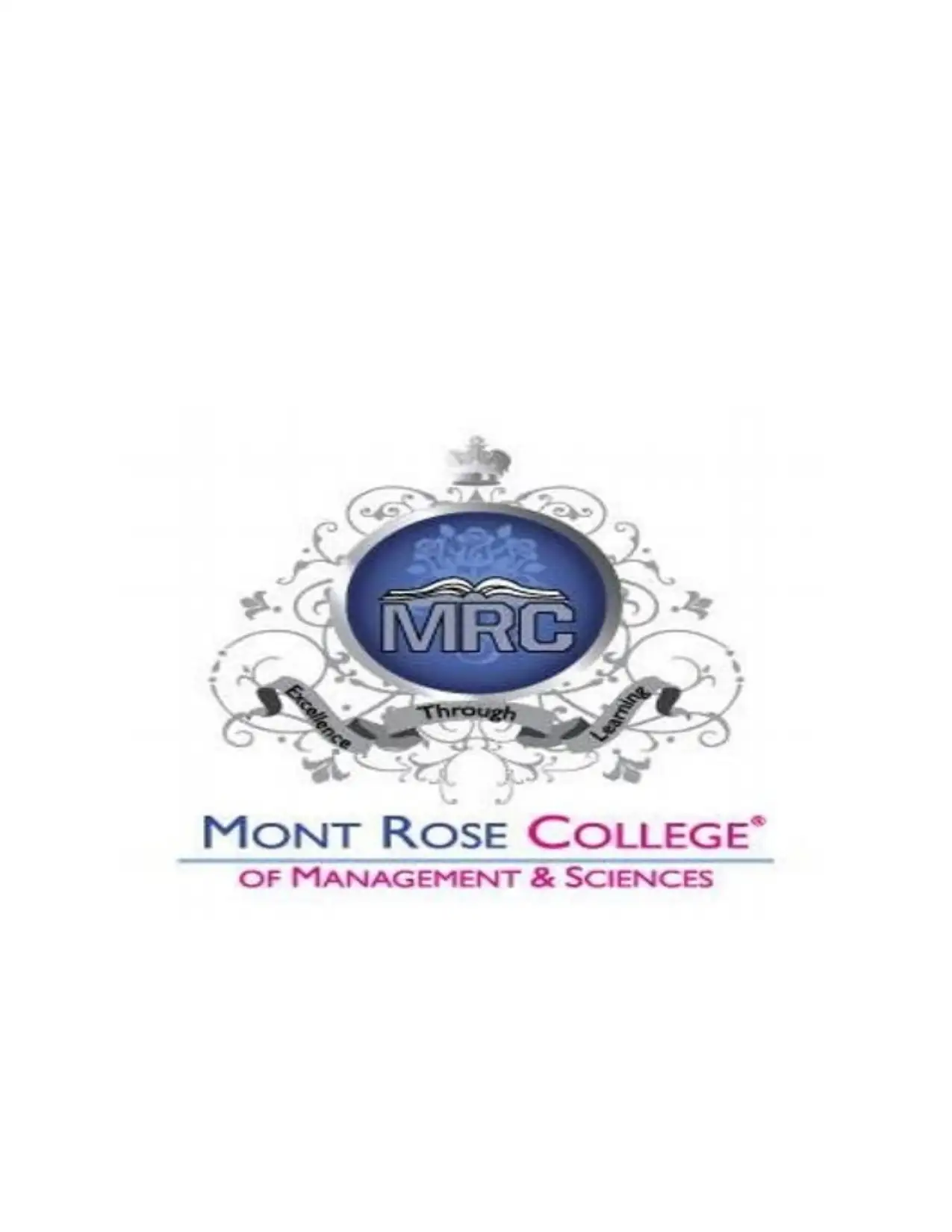
Paraphrase This Document
Need a fresh take? Get an instant paraphrase of this document with our AI Paraphraser
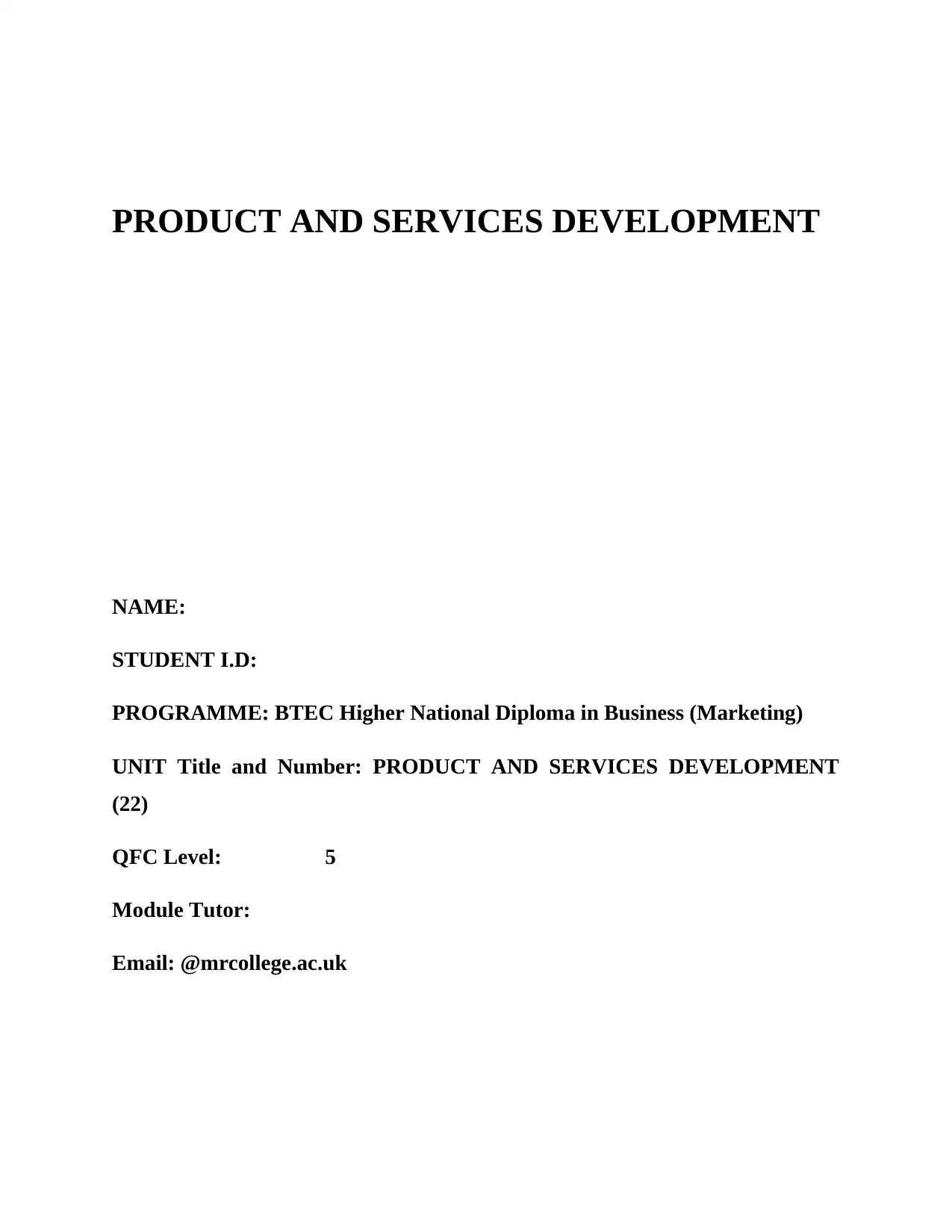
PRODUCT AND SERVICES DEVELOPMENT
NAME:
STUDENT I.D:
PROGRAMME: BTEC Higher National Diploma in Business (Marketing)
UNIT Title and Number: PRODUCT AND SERVICES DEVELOPMENT
(22)
QFC Level: 5
Module Tutor:
Email: @mrcollege.ac.uk
NAME:
STUDENT I.D:
PROGRAMME: BTEC Higher National Diploma in Business (Marketing)
UNIT Title and Number: PRODUCT AND SERVICES DEVELOPMENT
(22)
QFC Level: 5
Module Tutor:
Email: @mrcollege.ac.uk
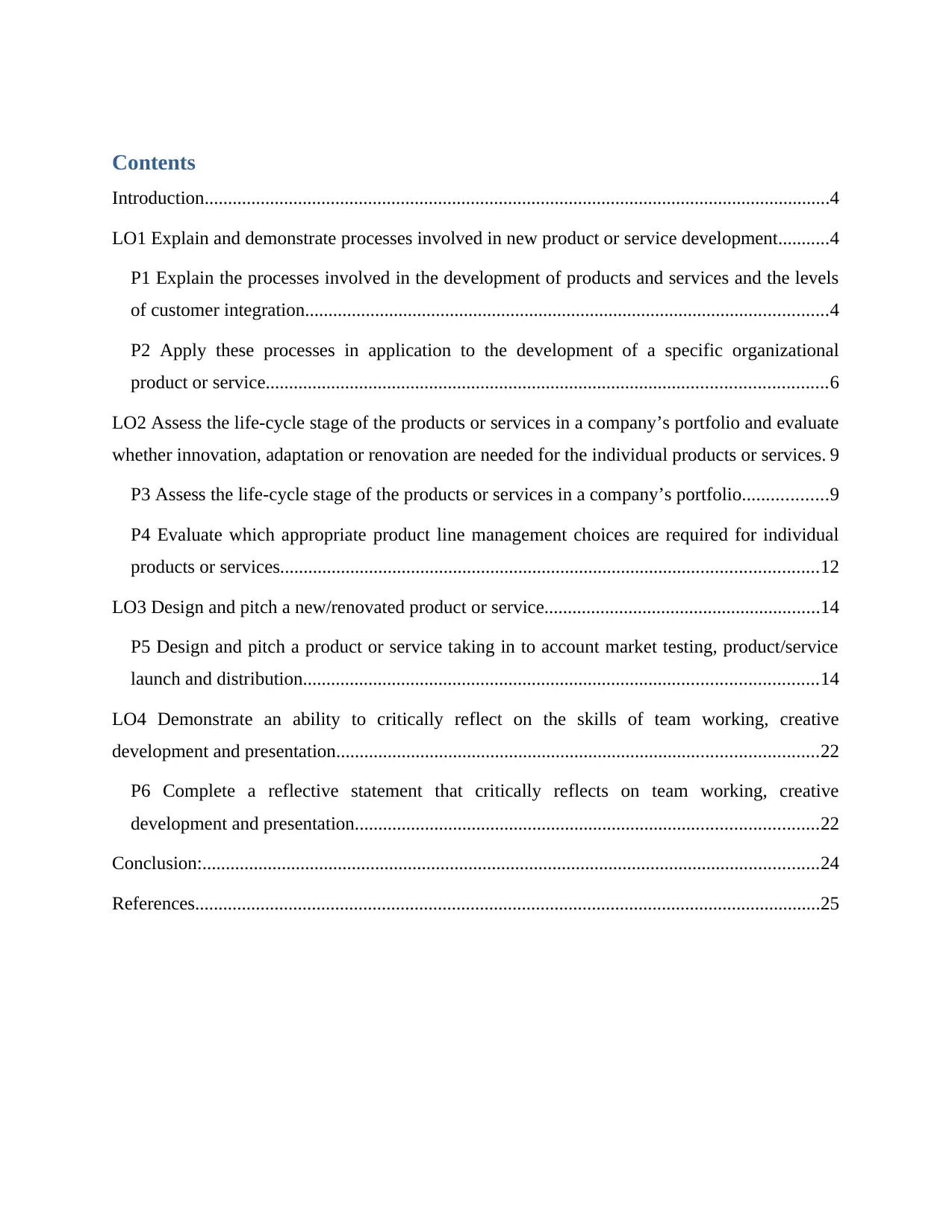
Contents
Introduction......................................................................................................................................4
LO1 Explain and demonstrate processes involved in new product or service development...........4
P1 Explain the processes involved in the development of products and services and the levels
of customer integration................................................................................................................4
P2 Apply these processes in application to the development of a specific organizational
product or service........................................................................................................................6
LO2 Assess the life-cycle stage of the products or services in a company’s portfolio and evaluate
whether innovation, adaptation or renovation are needed for the individual products or services. 9
P3 Assess the life-cycle stage of the products or services in a company’s portfolio..................9
P4 Evaluate which appropriate product line management choices are required for individual
products or services...................................................................................................................12
LO3 Design and pitch a new/renovated product or service...........................................................14
P5 Design and pitch a product or service taking in to account market testing, product/service
launch and distribution..............................................................................................................14
LO4 Demonstrate an ability to critically reflect on the skills of team working, creative
development and presentation.......................................................................................................22
P6 Complete a reflective statement that critically reflects on team working, creative
development and presentation...................................................................................................22
Conclusion:....................................................................................................................................24
References......................................................................................................................................25
Introduction......................................................................................................................................4
LO1 Explain and demonstrate processes involved in new product or service development...........4
P1 Explain the processes involved in the development of products and services and the levels
of customer integration................................................................................................................4
P2 Apply these processes in application to the development of a specific organizational
product or service........................................................................................................................6
LO2 Assess the life-cycle stage of the products or services in a company’s portfolio and evaluate
whether innovation, adaptation or renovation are needed for the individual products or services. 9
P3 Assess the life-cycle stage of the products or services in a company’s portfolio..................9
P4 Evaluate which appropriate product line management choices are required for individual
products or services...................................................................................................................12
LO3 Design and pitch a new/renovated product or service...........................................................14
P5 Design and pitch a product or service taking in to account market testing, product/service
launch and distribution..............................................................................................................14
LO4 Demonstrate an ability to critically reflect on the skills of team working, creative
development and presentation.......................................................................................................22
P6 Complete a reflective statement that critically reflects on team working, creative
development and presentation...................................................................................................22
Conclusion:....................................................................................................................................24
References......................................................................................................................................25
⊘ This is a preview!⊘
Do you want full access?
Subscribe today to unlock all pages.

Trusted by 1+ million students worldwide
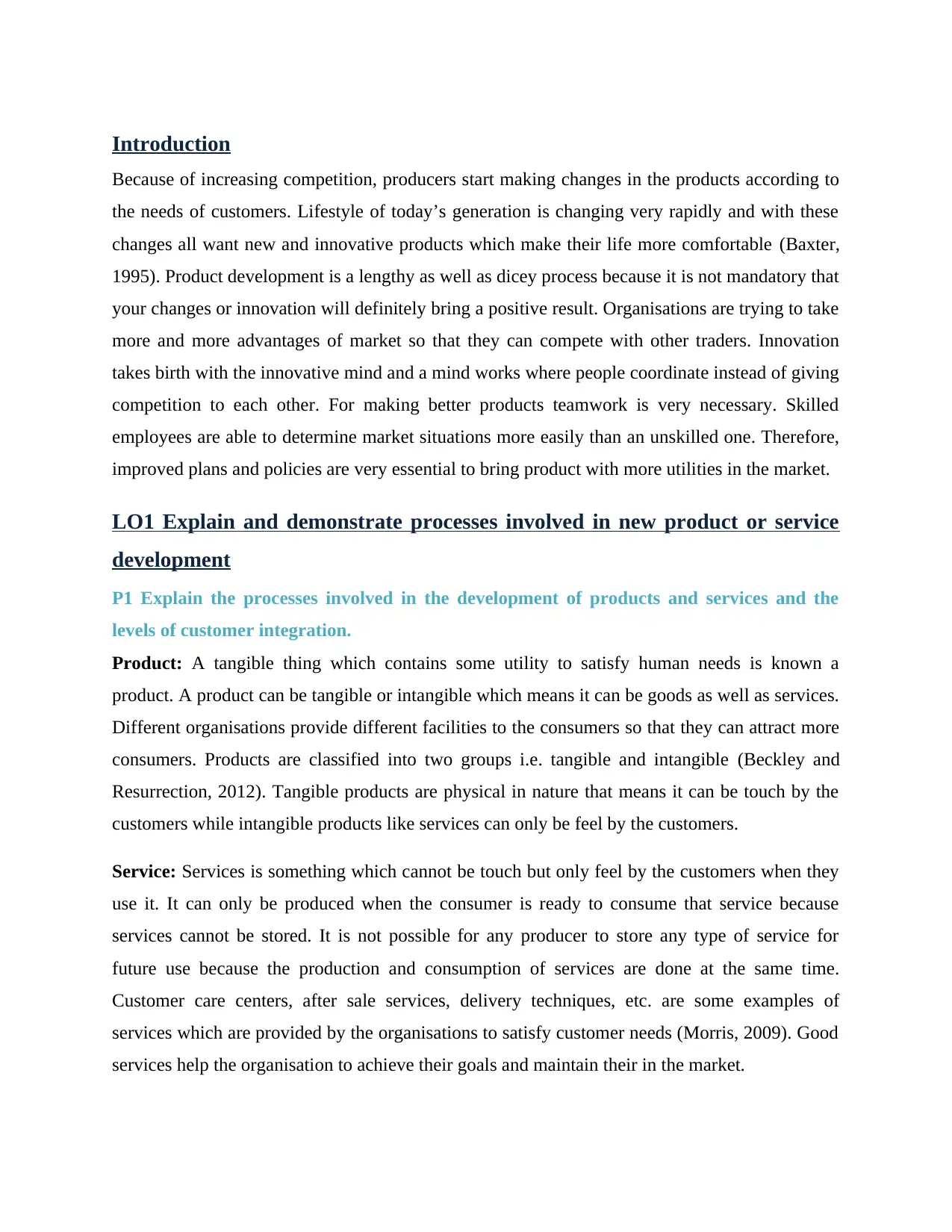
Introduction
Because of increasing competition, producers start making changes in the products according to
the needs of customers. Lifestyle of today’s generation is changing very rapidly and with these
changes all want new and innovative products which make their life more comfortable (Baxter,
1995). Product development is a lengthy as well as dicey process because it is not mandatory that
your changes or innovation will definitely bring a positive result. Organisations are trying to take
more and more advantages of market so that they can compete with other traders. Innovation
takes birth with the innovative mind and a mind works where people coordinate instead of giving
competition to each other. For making better products teamwork is very necessary. Skilled
employees are able to determine market situations more easily than an unskilled one. Therefore,
improved plans and policies are very essential to bring product with more utilities in the market.
LO1 Explain and demonstrate processes involved in new product or service
development
P1 Explain the processes involved in the development of products and services and the
levels of customer integration.
Product: A tangible thing which contains some utility to satisfy human needs is known a
product. A product can be tangible or intangible which means it can be goods as well as services.
Different organisations provide different facilities to the consumers so that they can attract more
consumers. Products are classified into two groups i.e. tangible and intangible (Beckley and
Resurrection, 2012). Tangible products are physical in nature that means it can be touch by the
customers while intangible products like services can only be feel by the customers.
Service: Services is something which cannot be touch but only feel by the customers when they
use it. It can only be produced when the consumer is ready to consume that service because
services cannot be stored. It is not possible for any producer to store any type of service for
future use because the production and consumption of services are done at the same time.
Customer care centers, after sale services, delivery techniques, etc. are some examples of
services which are provided by the organisations to satisfy customer needs (Morris, 2009). Good
services help the organisation to achieve their goals and maintain their in the market.
Because of increasing competition, producers start making changes in the products according to
the needs of customers. Lifestyle of today’s generation is changing very rapidly and with these
changes all want new and innovative products which make their life more comfortable (Baxter,
1995). Product development is a lengthy as well as dicey process because it is not mandatory that
your changes or innovation will definitely bring a positive result. Organisations are trying to take
more and more advantages of market so that they can compete with other traders. Innovation
takes birth with the innovative mind and a mind works where people coordinate instead of giving
competition to each other. For making better products teamwork is very necessary. Skilled
employees are able to determine market situations more easily than an unskilled one. Therefore,
improved plans and policies are very essential to bring product with more utilities in the market.
LO1 Explain and demonstrate processes involved in new product or service
development
P1 Explain the processes involved in the development of products and services and the
levels of customer integration.
Product: A tangible thing which contains some utility to satisfy human needs is known a
product. A product can be tangible or intangible which means it can be goods as well as services.
Different organisations provide different facilities to the consumers so that they can attract more
consumers. Products are classified into two groups i.e. tangible and intangible (Beckley and
Resurrection, 2012). Tangible products are physical in nature that means it can be touch by the
customers while intangible products like services can only be feel by the customers.
Service: Services is something which cannot be touch but only feel by the customers when they
use it. It can only be produced when the consumer is ready to consume that service because
services cannot be stored. It is not possible for any producer to store any type of service for
future use because the production and consumption of services are done at the same time.
Customer care centers, after sale services, delivery techniques, etc. are some examples of
services which are provided by the organisations to satisfy customer needs (Morris, 2009). Good
services help the organisation to achieve their goals and maintain their in the market.
Paraphrase This Document
Need a fresh take? Get an instant paraphrase of this document with our AI Paraphraser
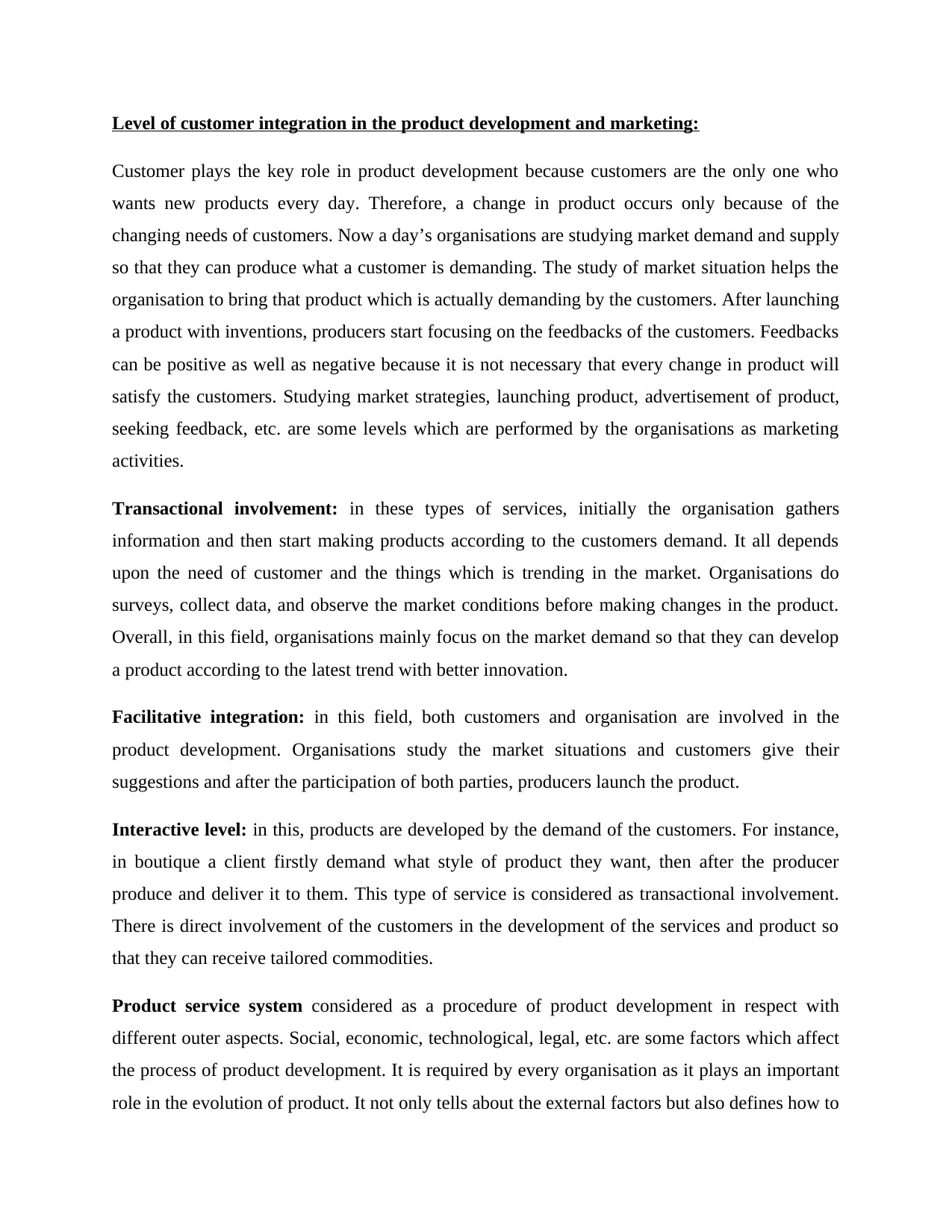
Level of customer integration in the product development and marketing:
Customer plays the key role in product development because customers are the only one who
wants new products every day. Therefore, a change in product occurs only because of the
changing needs of customers. Now a day’s organisations are studying market demand and supply
so that they can produce what a customer is demanding. The study of market situation helps the
organisation to bring that product which is actually demanding by the customers. After launching
a product with inventions, producers start focusing on the feedbacks of the customers. Feedbacks
can be positive as well as negative because it is not necessary that every change in product will
satisfy the customers. Studying market strategies, launching product, advertisement of product,
seeking feedback, etc. are some levels which are performed by the organisations as marketing
activities.
Transactional involvement: in these types of services, initially the organisation gathers
information and then start making products according to the customers demand. It all depends
upon the need of customer and the things which is trending in the market. Organisations do
surveys, collect data, and observe the market conditions before making changes in the product.
Overall, in this field, organisations mainly focus on the market demand so that they can develop
a product according to the latest trend with better innovation.
Facilitative integration: in this field, both customers and organisation are involved in the
product development. Organisations study the market situations and customers give their
suggestions and after the participation of both parties, producers launch the product.
Interactive level: in this, products are developed by the demand of the customers. For instance,
in boutique a client firstly demand what style of product they want, then after the producer
produce and deliver it to them. This type of service is considered as transactional involvement.
There is direct involvement of the customers in the development of the services and product so
that they can receive tailored commodities.
Product service system considered as a procedure of product development in respect with
different outer aspects. Social, economic, technological, legal, etc. are some factors which affect
the process of product development. It is required by every organisation as it plays an important
role in the evolution of product. It not only tells about the external factors but also defines how to
Customer plays the key role in product development because customers are the only one who
wants new products every day. Therefore, a change in product occurs only because of the
changing needs of customers. Now a day’s organisations are studying market demand and supply
so that they can produce what a customer is demanding. The study of market situation helps the
organisation to bring that product which is actually demanding by the customers. After launching
a product with inventions, producers start focusing on the feedbacks of the customers. Feedbacks
can be positive as well as negative because it is not necessary that every change in product will
satisfy the customers. Studying market strategies, launching product, advertisement of product,
seeking feedback, etc. are some levels which are performed by the organisations as marketing
activities.
Transactional involvement: in these types of services, initially the organisation gathers
information and then start making products according to the customers demand. It all depends
upon the need of customer and the things which is trending in the market. Organisations do
surveys, collect data, and observe the market conditions before making changes in the product.
Overall, in this field, organisations mainly focus on the market demand so that they can develop
a product according to the latest trend with better innovation.
Facilitative integration: in this field, both customers and organisation are involved in the
product development. Organisations study the market situations and customers give their
suggestions and after the participation of both parties, producers launch the product.
Interactive level: in this, products are developed by the demand of the customers. For instance,
in boutique a client firstly demand what style of product they want, then after the producer
produce and deliver it to them. This type of service is considered as transactional involvement.
There is direct involvement of the customers in the development of the services and product so
that they can receive tailored commodities.
Product service system considered as a procedure of product development in respect with
different outer aspects. Social, economic, technological, legal, etc. are some factors which affect
the process of product development. It is required by every organisation as it plays an important
role in the evolution of product. It not only tells about the external factors but also defines how to
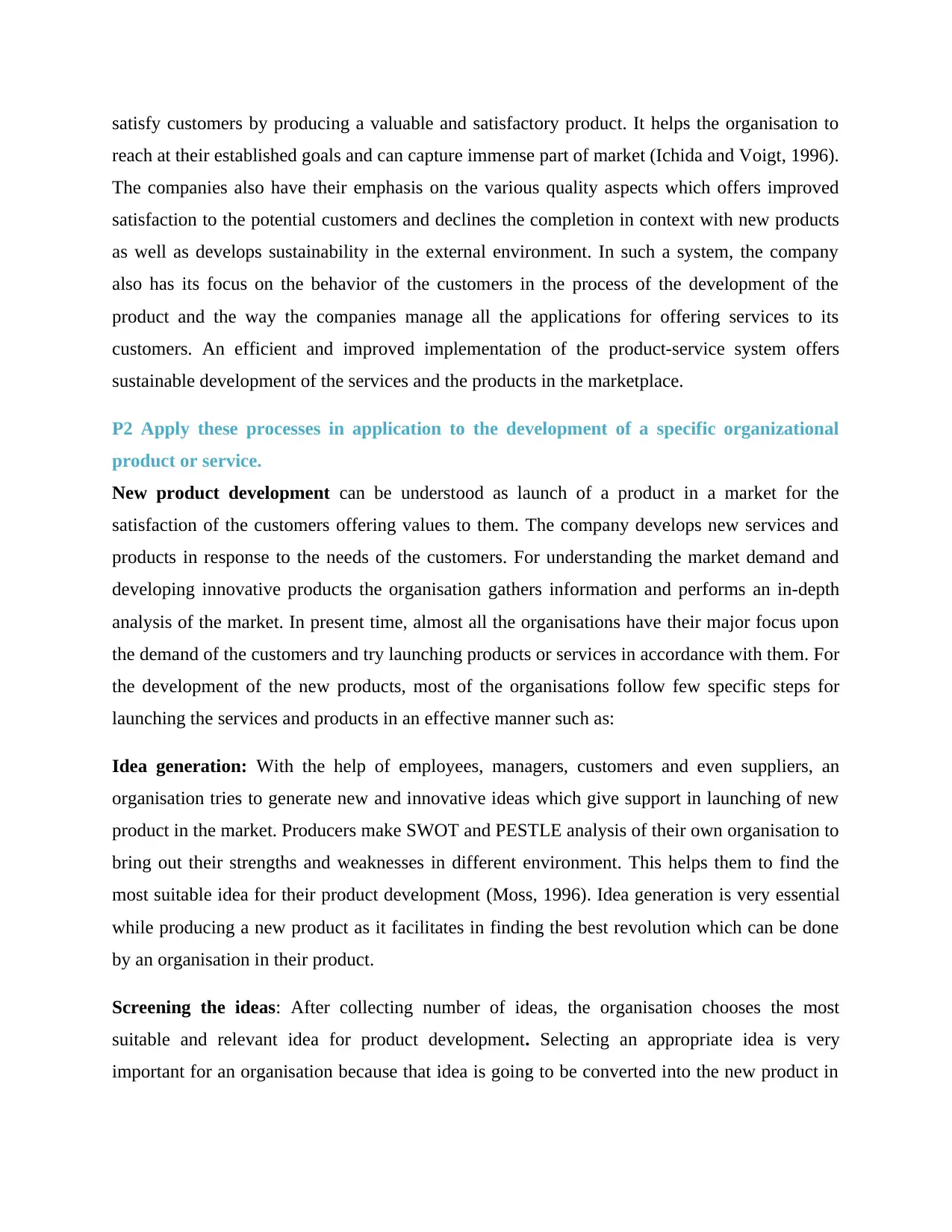
satisfy customers by producing a valuable and satisfactory product. It helps the organisation to
reach at their established goals and can capture immense part of market (Ichida and Voigt, 1996).
The companies also have their emphasis on the various quality aspects which offers improved
satisfaction to the potential customers and declines the completion in context with new products
as well as develops sustainability in the external environment. In such a system, the company
also has its focus on the behavior of the customers in the process of the development of the
product and the way the companies manage all the applications for offering services to its
customers. An efficient and improved implementation of the product-service system offers
sustainable development of the services and the products in the marketplace.
P2 Apply these processes in application to the development of a specific organizational
product or service.
New product development can be understood as launch of a product in a market for the
satisfaction of the customers offering values to them. The company develops new services and
products in response to the needs of the customers. For understanding the market demand and
developing innovative products the organisation gathers information and performs an in-depth
analysis of the market. In present time, almost all the organisations have their major focus upon
the demand of the customers and try launching products or services in accordance with them. For
the development of the new products, most of the organisations follow few specific steps for
launching the services and products in an effective manner such as:
Idea generation: With the help of employees, managers, customers and even suppliers, an
organisation tries to generate new and innovative ideas which give support in launching of new
product in the market. Producers make SWOT and PESTLE analysis of their own organisation to
bring out their strengths and weaknesses in different environment. This helps them to find the
most suitable idea for their product development (Moss, 1996). Idea generation is very essential
while producing a new product as it facilitates in finding the best revolution which can be done
by an organisation in their product.
Screening the ideas: After collecting number of ideas, the organisation chooses the most
suitable and relevant idea for product development. Selecting an appropriate idea is very
important for an organisation because that idea is going to be converted into the new product in
reach at their established goals and can capture immense part of market (Ichida and Voigt, 1996).
The companies also have their emphasis on the various quality aspects which offers improved
satisfaction to the potential customers and declines the completion in context with new products
as well as develops sustainability in the external environment. In such a system, the company
also has its focus on the behavior of the customers in the process of the development of the
product and the way the companies manage all the applications for offering services to its
customers. An efficient and improved implementation of the product-service system offers
sustainable development of the services and the products in the marketplace.
P2 Apply these processes in application to the development of a specific organizational
product or service.
New product development can be understood as launch of a product in a market for the
satisfaction of the customers offering values to them. The company develops new services and
products in response to the needs of the customers. For understanding the market demand and
developing innovative products the organisation gathers information and performs an in-depth
analysis of the market. In present time, almost all the organisations have their major focus upon
the demand of the customers and try launching products or services in accordance with them. For
the development of the new products, most of the organisations follow few specific steps for
launching the services and products in an effective manner such as:
Idea generation: With the help of employees, managers, customers and even suppliers, an
organisation tries to generate new and innovative ideas which give support in launching of new
product in the market. Producers make SWOT and PESTLE analysis of their own organisation to
bring out their strengths and weaknesses in different environment. This helps them to find the
most suitable idea for their product development (Moss, 1996). Idea generation is very essential
while producing a new product as it facilitates in finding the best revolution which can be done
by an organisation in their product.
Screening the ideas: After collecting number of ideas, the organisation chooses the most
suitable and relevant idea for product development. Selecting an appropriate idea is very
important for an organisation because that idea is going to be converted into the new product in
⊘ This is a preview!⊘
Do you want full access?
Subscribe today to unlock all pages.

Trusted by 1+ million students worldwide
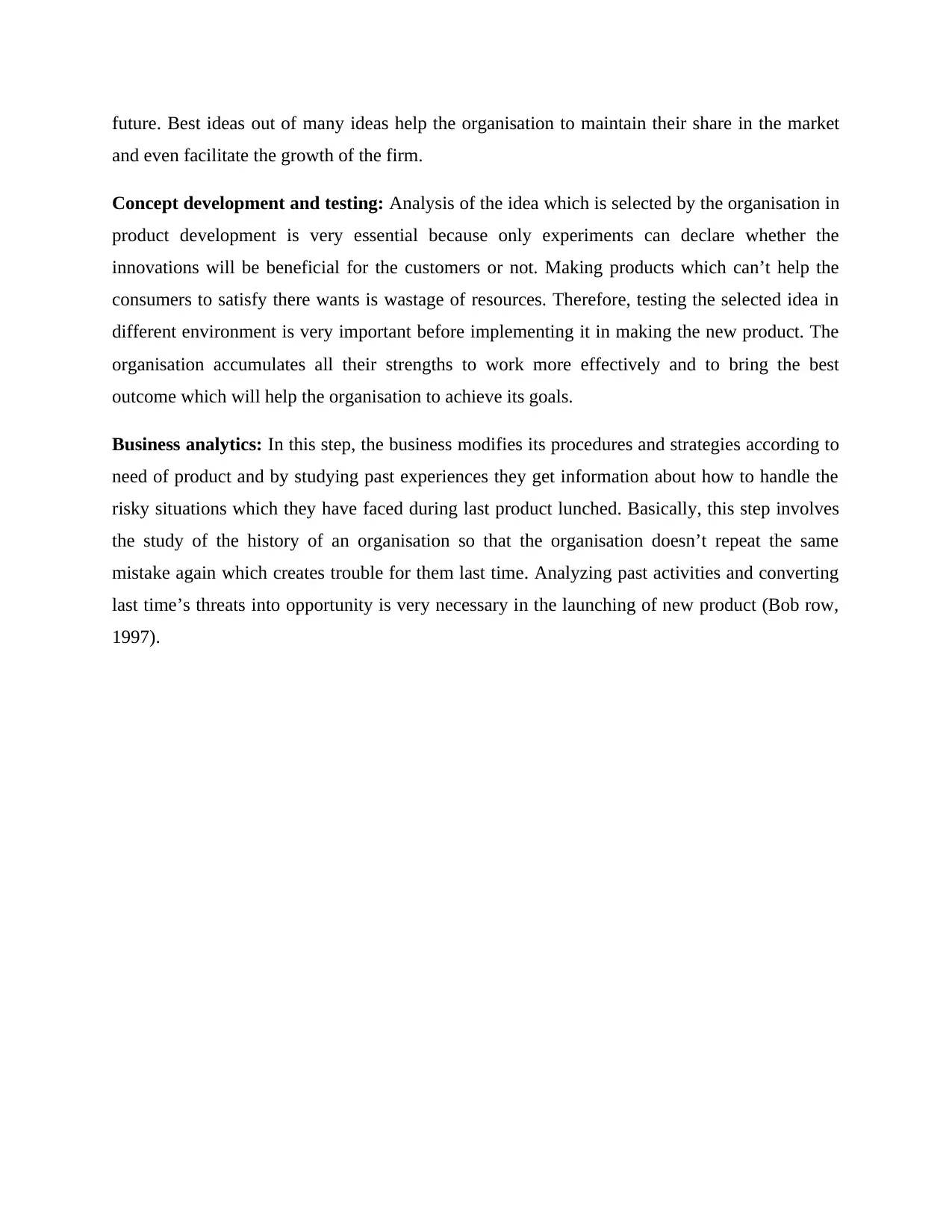
future. Best ideas out of many ideas help the organisation to maintain their share in the market
and even facilitate the growth of the firm.
Concept development and testing: Analysis of the idea which is selected by the organisation in
product development is very essential because only experiments can declare whether the
innovations will be beneficial for the customers or not. Making products which can’t help the
consumers to satisfy there wants is wastage of resources. Therefore, testing the selected idea in
different environment is very important before implementing it in making the new product. The
organisation accumulates all their strengths to work more effectively and to bring the best
outcome which will help the organisation to achieve its goals.
Business analytics: In this step, the business modifies its procedures and strategies according to
need of product and by studying past experiences they get information about how to handle the
risky situations which they have faced during last product lunched. Basically, this step involves
the study of the history of an organisation so that the organisation doesn’t repeat the same
mistake again which creates trouble for them last time. Analyzing past activities and converting
last time’s threats into opportunity is very necessary in the launching of new product (Bob row,
1997).
and even facilitate the growth of the firm.
Concept development and testing: Analysis of the idea which is selected by the organisation in
product development is very essential because only experiments can declare whether the
innovations will be beneficial for the customers or not. Making products which can’t help the
consumers to satisfy there wants is wastage of resources. Therefore, testing the selected idea in
different environment is very important before implementing it in making the new product. The
organisation accumulates all their strengths to work more effectively and to bring the best
outcome which will help the organisation to achieve its goals.
Business analytics: In this step, the business modifies its procedures and strategies according to
need of product and by studying past experiences they get information about how to handle the
risky situations which they have faced during last product lunched. Basically, this step involves
the study of the history of an organisation so that the organisation doesn’t repeat the same
mistake again which creates trouble for them last time. Analyzing past activities and converting
last time’s threats into opportunity is very necessary in the launching of new product (Bob row,
1997).
Paraphrase This Document
Need a fresh take? Get an instant paraphrase of this document with our AI Paraphraser
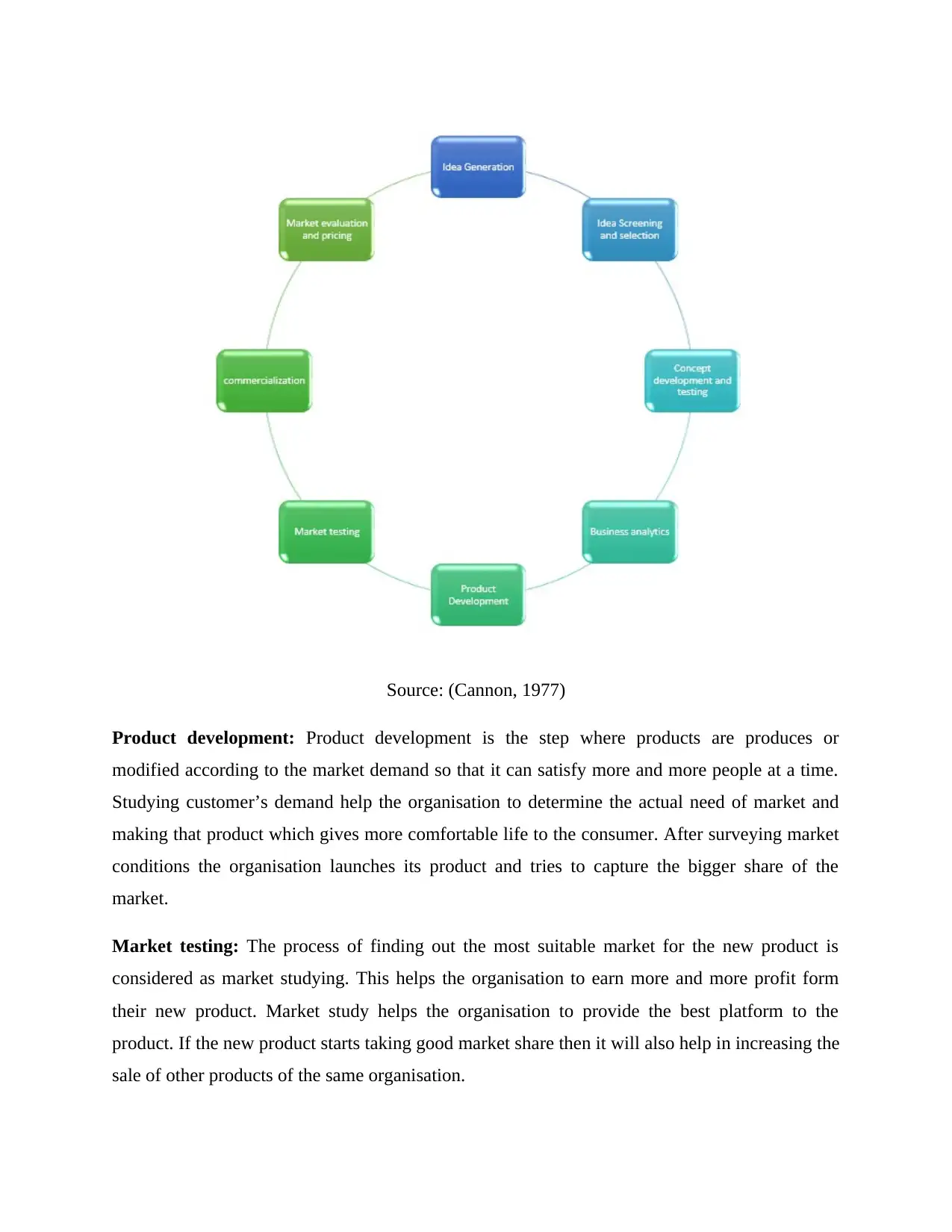
Source: (Cannon, 1977)
Product development: Product development is the step where products are produces or
modified according to the market demand so that it can satisfy more and more people at a time.
Studying customer’s demand help the organisation to determine the actual need of market and
making that product which gives more comfortable life to the consumer. After surveying market
conditions the organisation launches its product and tries to capture the bigger share of the
market.
Market testing: The process of finding out the most suitable market for the new product is
considered as market studying. This helps the organisation to earn more and more profit form
their new product. Market study helps the organisation to provide the best platform to the
product. If the new product starts taking good market share then it will also help in increasing the
sale of other products of the same organisation.
Product development: Product development is the step where products are produces or
modified according to the market demand so that it can satisfy more and more people at a time.
Studying customer’s demand help the organisation to determine the actual need of market and
making that product which gives more comfortable life to the consumer. After surveying market
conditions the organisation launches its product and tries to capture the bigger share of the
market.
Market testing: The process of finding out the most suitable market for the new product is
considered as market studying. This helps the organisation to earn more and more profit form
their new product. Market study helps the organisation to provide the best platform to the
product. If the new product starts taking good market share then it will also help in increasing the
sale of other products of the same organisation.
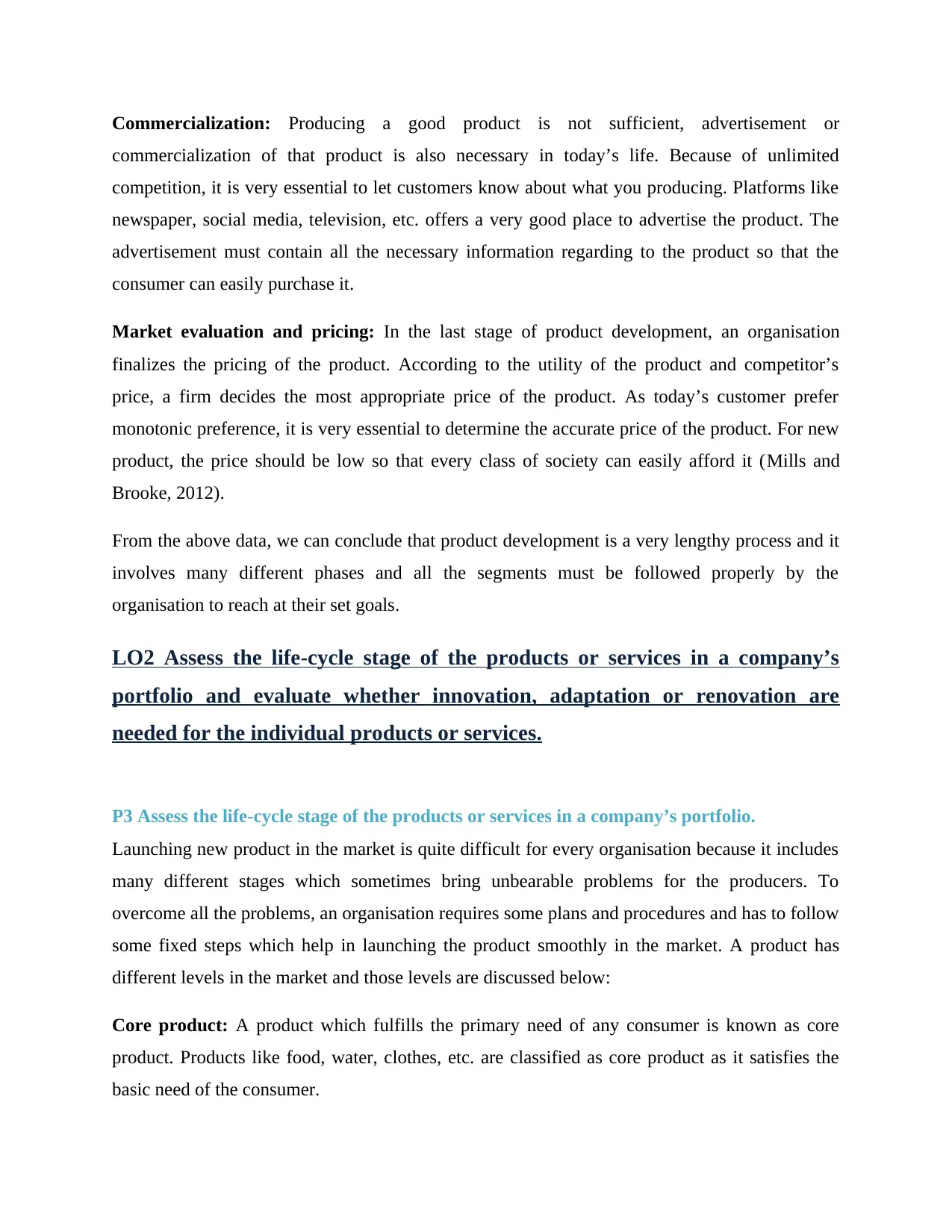
Commercialization: Producing a good product is not sufficient, advertisement or
commercialization of that product is also necessary in today’s life. Because of unlimited
competition, it is very essential to let customers know about what you producing. Platforms like
newspaper, social media, television, etc. offers a very good place to advertise the product. The
advertisement must contain all the necessary information regarding to the product so that the
consumer can easily purchase it.
Market evaluation and pricing: In the last stage of product development, an organisation
finalizes the pricing of the product. According to the utility of the product and competitor’s
price, a firm decides the most appropriate price of the product. As today’s customer prefer
monotonic preference, it is very essential to determine the accurate price of the product. For new
product, the price should be low so that every class of society can easily afford it (Mills and
Brooke, 2012).
From the above data, we can conclude that product development is a very lengthy process and it
involves many different phases and all the segments must be followed properly by the
organisation to reach at their set goals.
LO2 Assess the life-cycle stage of the products or services in a company’s
portfolio and evaluate whether innovation, adaptation or renovation are
needed for the individual products or services.
P3 Assess the life-cycle stage of the products or services in a company’s portfolio.
Launching new product in the market is quite difficult for every organisation because it includes
many different stages which sometimes bring unbearable problems for the producers. To
overcome all the problems, an organisation requires some plans and procedures and has to follow
some fixed steps which help in launching the product smoothly in the market. A product has
different levels in the market and those levels are discussed below:
Core product: A product which fulfills the primary need of any consumer is known as core
product. Products like food, water, clothes, etc. are classified as core product as it satisfies the
basic need of the consumer.
commercialization of that product is also necessary in today’s life. Because of unlimited
competition, it is very essential to let customers know about what you producing. Platforms like
newspaper, social media, television, etc. offers a very good place to advertise the product. The
advertisement must contain all the necessary information regarding to the product so that the
consumer can easily purchase it.
Market evaluation and pricing: In the last stage of product development, an organisation
finalizes the pricing of the product. According to the utility of the product and competitor’s
price, a firm decides the most appropriate price of the product. As today’s customer prefer
monotonic preference, it is very essential to determine the accurate price of the product. For new
product, the price should be low so that every class of society can easily afford it (Mills and
Brooke, 2012).
From the above data, we can conclude that product development is a very lengthy process and it
involves many different phases and all the segments must be followed properly by the
organisation to reach at their set goals.
LO2 Assess the life-cycle stage of the products or services in a company’s
portfolio and evaluate whether innovation, adaptation or renovation are
needed for the individual products or services.
P3 Assess the life-cycle stage of the products or services in a company’s portfolio.
Launching new product in the market is quite difficult for every organisation because it includes
many different stages which sometimes bring unbearable problems for the producers. To
overcome all the problems, an organisation requires some plans and procedures and has to follow
some fixed steps which help in launching the product smoothly in the market. A product has
different levels in the market and those levels are discussed below:
Core product: A product which fulfills the primary need of any consumer is known as core
product. Products like food, water, clothes, etc. are classified as core product as it satisfies the
basic need of the consumer.
⊘ This is a preview!⊘
Do you want full access?
Subscribe today to unlock all pages.

Trusted by 1+ million students worldwide
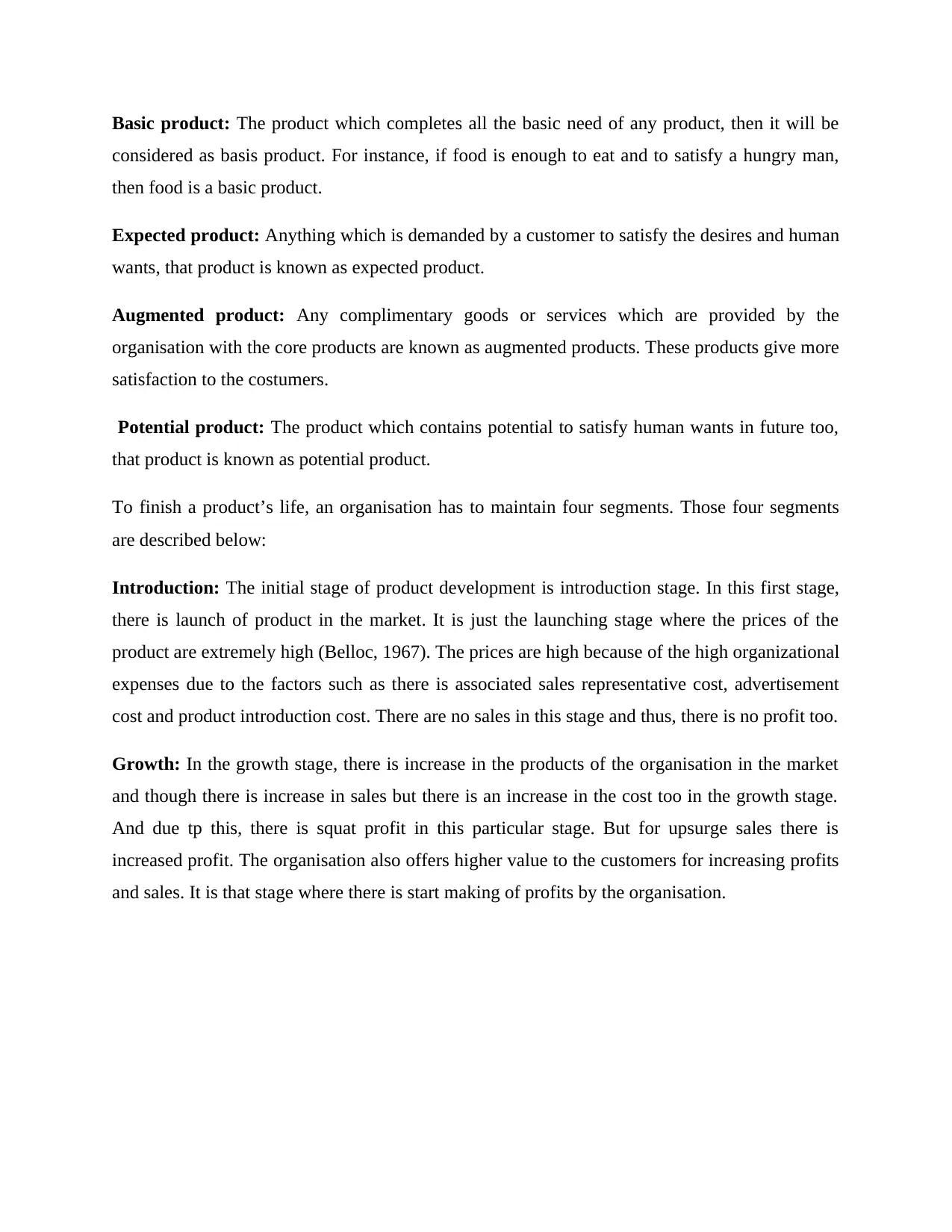
Basic product: The product which completes all the basic need of any product, then it will be
considered as basis product. For instance, if food is enough to eat and to satisfy a hungry man,
then food is a basic product.
Expected product: Anything which is demanded by a customer to satisfy the desires and human
wants, that product is known as expected product.
Augmented product: Any complimentary goods or services which are provided by the
organisation with the core products are known as augmented products. These products give more
satisfaction to the costumers.
Potential product: The product which contains potential to satisfy human wants in future too,
that product is known as potential product.
To finish a product’s life, an organisation has to maintain four segments. Those four segments
are described below:
Introduction: The initial stage of product development is introduction stage. In this first stage,
there is launch of product in the market. It is just the launching stage where the prices of the
product are extremely high (Belloc, 1967). The prices are high because of the high organizational
expenses due to the factors such as there is associated sales representative cost, advertisement
cost and product introduction cost. There are no sales in this stage and thus, there is no profit too.
Growth: In the growth stage, there is increase in the products of the organisation in the market
and though there is increase in sales but there is an increase in the cost too in the growth stage.
And due tp this, there is squat profit in this particular stage. But for upsurge sales there is
increased profit. The organisation also offers higher value to the customers for increasing profits
and sales. It is that stage where there is start making of profits by the organisation.
considered as basis product. For instance, if food is enough to eat and to satisfy a hungry man,
then food is a basic product.
Expected product: Anything which is demanded by a customer to satisfy the desires and human
wants, that product is known as expected product.
Augmented product: Any complimentary goods or services which are provided by the
organisation with the core products are known as augmented products. These products give more
satisfaction to the costumers.
Potential product: The product which contains potential to satisfy human wants in future too,
that product is known as potential product.
To finish a product’s life, an organisation has to maintain four segments. Those four segments
are described below:
Introduction: The initial stage of product development is introduction stage. In this first stage,
there is launch of product in the market. It is just the launching stage where the prices of the
product are extremely high (Belloc, 1967). The prices are high because of the high organizational
expenses due to the factors such as there is associated sales representative cost, advertisement
cost and product introduction cost. There are no sales in this stage and thus, there is no profit too.
Growth: In the growth stage, there is increase in the products of the organisation in the market
and though there is increase in sales but there is an increase in the cost too in the growth stage.
And due tp this, there is squat profit in this particular stage. But for upsurge sales there is
increased profit. The organisation also offers higher value to the customers for increasing profits
and sales. It is that stage where there is start making of profits by the organisation.
Paraphrase This Document
Need a fresh take? Get an instant paraphrase of this document with our AI Paraphraser
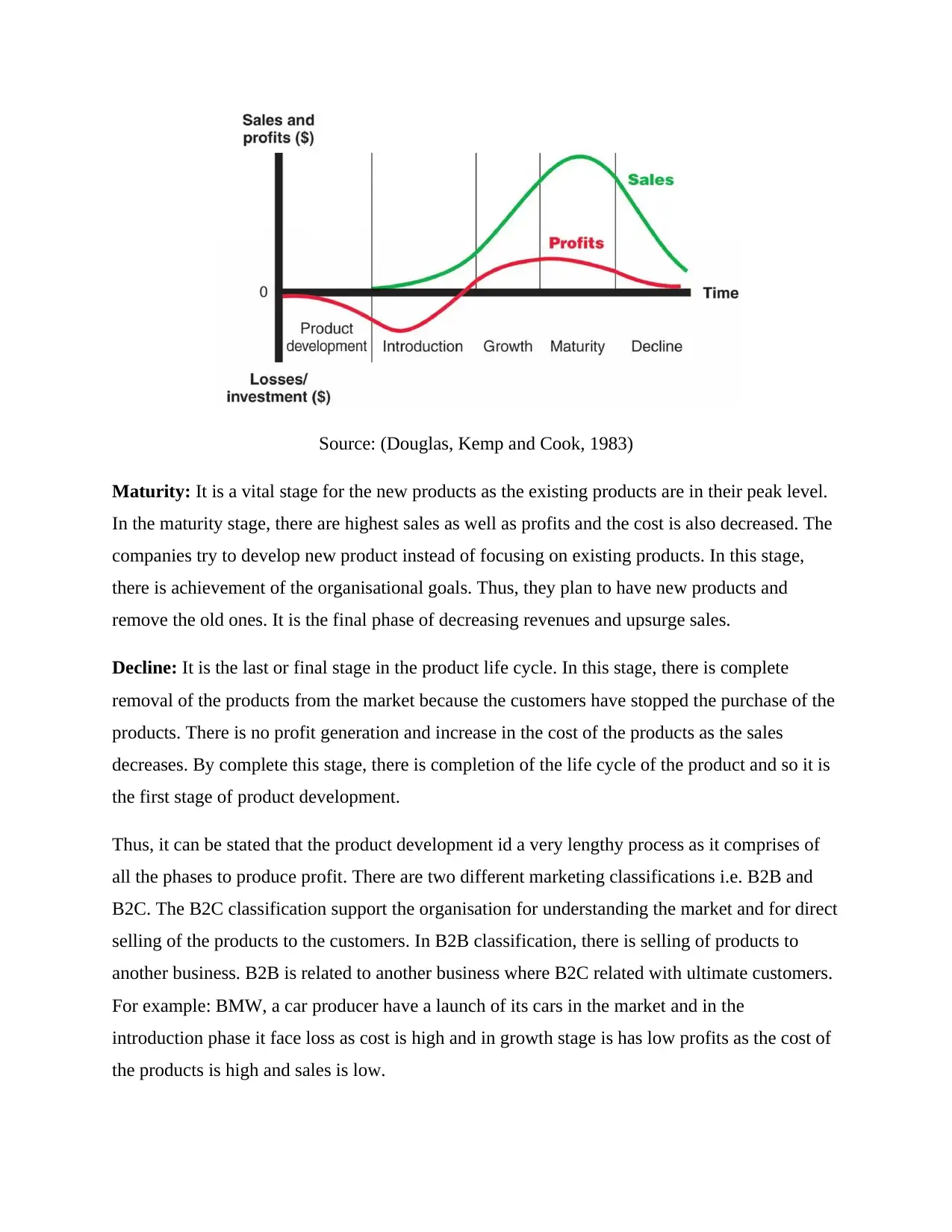
Source: (Douglas, Kemp and Cook, 1983)
Maturity: It is a vital stage for the new products as the existing products are in their peak level.
In the maturity stage, there are highest sales as well as profits and the cost is also decreased. The
companies try to develop new product instead of focusing on existing products. In this stage,
there is achievement of the organisational goals. Thus, they plan to have new products and
remove the old ones. It is the final phase of decreasing revenues and upsurge sales.
Decline: It is the last or final stage in the product life cycle. In this stage, there is complete
removal of the products from the market because the customers have stopped the purchase of the
products. There is no profit generation and increase in the cost of the products as the sales
decreases. By complete this stage, there is completion of the life cycle of the product and so it is
the first stage of product development.
Thus, it can be stated that the product development id a very lengthy process as it comprises of
all the phases to produce profit. There are two different marketing classifications i.e. B2B and
B2C. The B2C classification support the organisation for understanding the market and for direct
selling of the products to the customers. In B2B classification, there is selling of products to
another business. B2B is related to another business where B2C related with ultimate customers.
For example: BMW, a car producer have a launch of its cars in the market and in the
introduction phase it face loss as cost is high and in growth stage is has low profits as the cost of
the products is high and sales is low.
Maturity: It is a vital stage for the new products as the existing products are in their peak level.
In the maturity stage, there are highest sales as well as profits and the cost is also decreased. The
companies try to develop new product instead of focusing on existing products. In this stage,
there is achievement of the organisational goals. Thus, they plan to have new products and
remove the old ones. It is the final phase of decreasing revenues and upsurge sales.
Decline: It is the last or final stage in the product life cycle. In this stage, there is complete
removal of the products from the market because the customers have stopped the purchase of the
products. There is no profit generation and increase in the cost of the products as the sales
decreases. By complete this stage, there is completion of the life cycle of the product and so it is
the first stage of product development.
Thus, it can be stated that the product development id a very lengthy process as it comprises of
all the phases to produce profit. There are two different marketing classifications i.e. B2B and
B2C. The B2C classification support the organisation for understanding the market and for direct
selling of the products to the customers. In B2B classification, there is selling of products to
another business. B2B is related to another business where B2C related with ultimate customers.
For example: BMW, a car producer have a launch of its cars in the market and in the
introduction phase it face loss as cost is high and in growth stage is has low profits as the cost of
the products is high and sales is low.
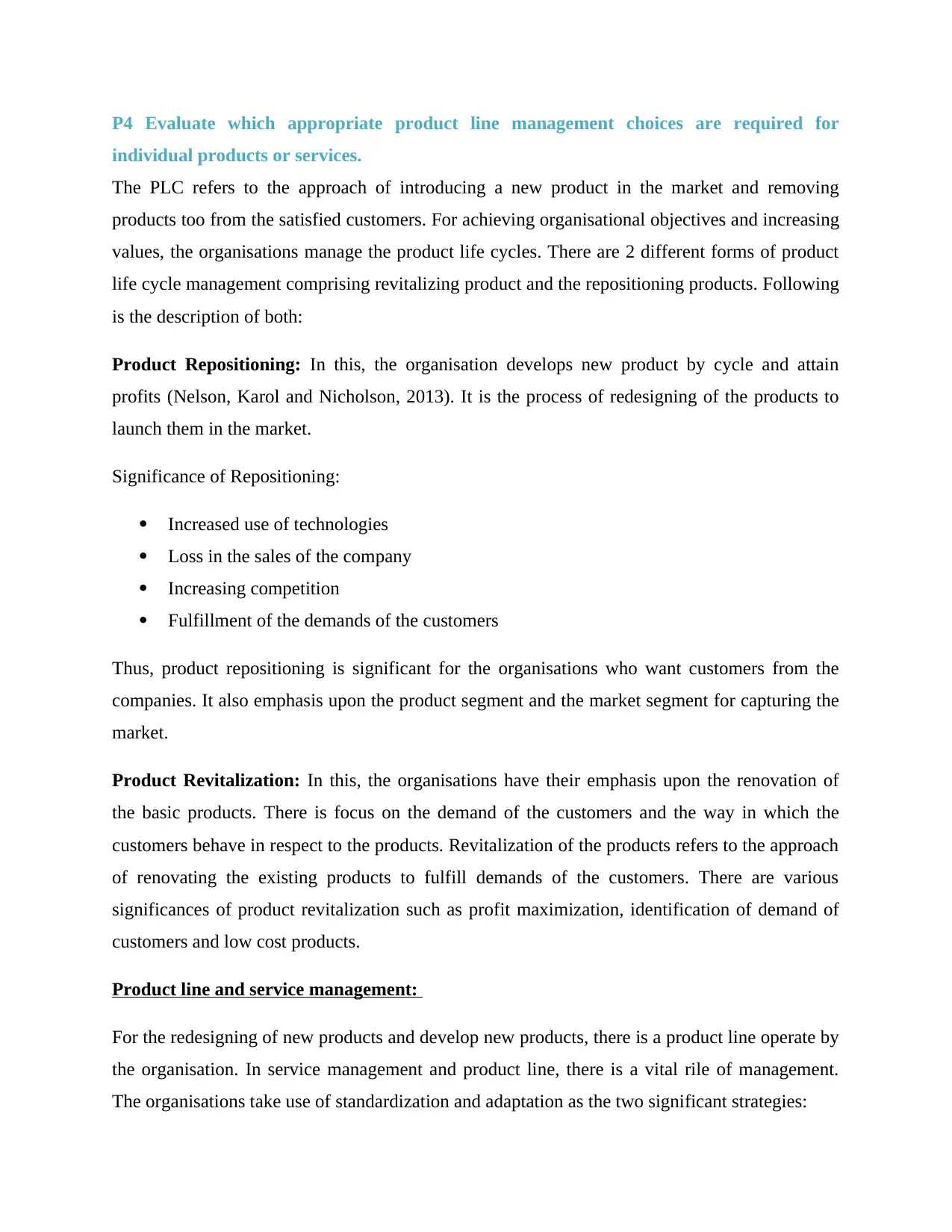
P4 Evaluate which appropriate product line management choices are required for
individual products or services.
The PLC refers to the approach of introducing a new product in the market and removing
products too from the satisfied customers. For achieving organisational objectives and increasing
values, the organisations manage the product life cycles. There are 2 different forms of product
life cycle management comprising revitalizing product and the repositioning products. Following
is the description of both:
Product Repositioning: In this, the organisation develops new product by cycle and attain
profits (Nelson, Karol and Nicholson, 2013). It is the process of redesigning of the products to
launch them in the market.
Significance of Repositioning:
Increased use of technologies
Loss in the sales of the company
Increasing competition
Fulfillment of the demands of the customers
Thus, product repositioning is significant for the organisations who want customers from the
companies. It also emphasis upon the product segment and the market segment for capturing the
market.
Product Revitalization: In this, the organisations have their emphasis upon the renovation of
the basic products. There is focus on the demand of the customers and the way in which the
customers behave in respect to the products. Revitalization of the products refers to the approach
of renovating the existing products to fulfill demands of the customers. There are various
significances of product revitalization such as profit maximization, identification of demand of
customers and low cost products.
Product line and service management:
For the redesigning of new products and develop new products, there is a product line operate by
the organisation. In service management and product line, there is a vital rile of management.
The organisations take use of standardization and adaptation as the two significant strategies:
individual products or services.
The PLC refers to the approach of introducing a new product in the market and removing
products too from the satisfied customers. For achieving organisational objectives and increasing
values, the organisations manage the product life cycles. There are 2 different forms of product
life cycle management comprising revitalizing product and the repositioning products. Following
is the description of both:
Product Repositioning: In this, the organisation develops new product by cycle and attain
profits (Nelson, Karol and Nicholson, 2013). It is the process of redesigning of the products to
launch them in the market.
Significance of Repositioning:
Increased use of technologies
Loss in the sales of the company
Increasing competition
Fulfillment of the demands of the customers
Thus, product repositioning is significant for the organisations who want customers from the
companies. It also emphasis upon the product segment and the market segment for capturing the
market.
Product Revitalization: In this, the organisations have their emphasis upon the renovation of
the basic products. There is focus on the demand of the customers and the way in which the
customers behave in respect to the products. Revitalization of the products refers to the approach
of renovating the existing products to fulfill demands of the customers. There are various
significances of product revitalization such as profit maximization, identification of demand of
customers and low cost products.
Product line and service management:
For the redesigning of new products and develop new products, there is a product line operate by
the organisation. In service management and product line, there is a vital rile of management.
The organisations take use of standardization and adaptation as the two significant strategies:
⊘ This is a preview!⊘
Do you want full access?
Subscribe today to unlock all pages.

Trusted by 1+ million students worldwide
1 out of 26
Related Documents
Your All-in-One AI-Powered Toolkit for Academic Success.
+13062052269
info@desklib.com
Available 24*7 on WhatsApp / Email
![[object Object]](/_next/static/media/star-bottom.7253800d.svg)
Unlock your academic potential
Copyright © 2020–2025 A2Z Services. All Rights Reserved. Developed and managed by ZUCOL.





